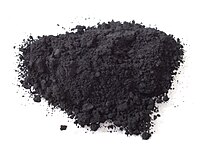
Photo from wikipedia
Nonlinear finite element (FE) simulations to characterize lightning-induced thermal damage in AS4/3506 carbon/epoxy composites with metallic and nonmetallic protection layers were performed and then compared with those for unprotected composites.… Click to show full abstract
Nonlinear finite element (FE) simulations to characterize lightning-induced thermal damage in AS4/3506 carbon/epoxy composites with metallic and nonmetallic protection layers were performed and then compared with those for unprotected composites. In this study, FE estimates of matrix thermal decomposition in composites subjected to 40 kA peak currents were performed. Two protection layers were considered: (1) a traditional copper mesh (CM) commonly used for aircraft lightning strike protection and (2) a single layer of highly conductive pitch carbon fiber paper (PCFP). Temperature-dependent material properties of each constituent were used to predict the matrix thermal decomposition induced by simulated lightning current waveforms. The lightning strike FE models suggest that both the CM and the PCFP lightning protection layers successfully mitigated thermal damage development in the underlying composites as a consequence of reduced through-thickness electrical current flow/heat conduction. The CM provided excellent protection from thermal damage; the predicted matrix decomposition only penetrated the first AS4/3506 ply. Similarly, the PCFP outer layer limited thermal damage to the top three composite plies, while the predicted matrix decomposition of the unprotected composite penetrated the sixth ply. Improved PCFP protection layers appear possible to design by varying the in-plane and through-thickness electrical conductivities, as well as the PCFP-to-first ply gap conductance. This suggests that PCFP outer layers or similar lightweight carbon-based layers may serve as efficient lightning protection layers. POLYM. COMPOS., 2017. © 2017 Society of Plastics Engineers
Journal Title: Polymer Composites
Year Published: 2018
Link to full text (if available)
Share on Social Media: Sign Up to like & get
recommendations!